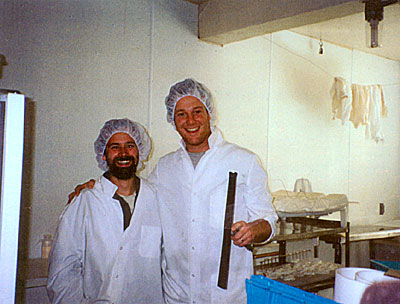 |
| Stuart Grande (left), a University of Maine Sustainable Agriculture Program graduate, and George van Vlaanderen in the cheese room at Doe’s Leap Farm in Vermont. Kristan Doolan photo. |
By Tim King
Kristan Doolan and George van Vlaanderen, owners of Doe’s Leap organic goat dairy in East Fairfield, Vermont, are trying an experiment. Actually, their whole farm is sort of a departure from the norm.
On the face of it, their most experimental project is using managed intensive grazing for their herd of 20 Nubian milking does along with their kids and three bucks. Some farmers provide their goat herds with access to pasture, but the majority don’t rely on grass from the pastures for nourishment. They are fed alfalfa hay and grain supplements in lots or barns. During Vermont’s grazing season, Kristan and George’s goats, however, rely almost entirely on the 125-acre farm’s pastures.
Management intensive grazing was designed by dairy and beef cow farmers and is also used by sheep farmers and ranchers. The idea is to create a series of small paddocks enclosed by highly portable, usually electric, fences. Each paddock needs to have a supply of water. Livestock are moved into the paddocks when the grass is lush, usually in fairly large numbers of animals in a small area. Then, in perhaps 12 to 48 hours, the livestock are moved out of that paddock and into a new one, while the grass in the grazed paddock recuperates for a month. Thus, intensive grazing always has livestock on the best forage. Intensively grazed grass has healthier root systems, and, as a result, the soil under it holds more water and nutrients. Kristan and George rotate their goats through the grass paddocks every 12 to 24 hours depending on the condition of the grass.
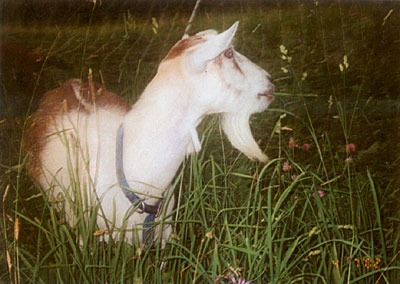 |
| A grazing Alpine cross goat. Kristan Doolan photo. |
But doing the unusual thing by putting their goats on grass isn’t where the two stopped. “Grazing systems frequently used for cattle and sheep are not well suited to goats due to their sensitivity to internal parasites and their desire for a wide variety of plant species, especially browse. Additionally, unlike cattle and sheep, dairy goats have not been genetically selected for grazing efficiency, because goat dairies in this country are generally confinement operations,” Kristan wrote in 1999 in a producer grant proposal to the United States Department of Agriculture’s Sustainable Agriculture Research and Education (SARE) program.
Effective grazing programs involve careful observation of livestock and a good understanding of what’s happening on your farm. When Kristan wrote the grant proposal, she and George were observing two things: Some goats on grass were being negatively affected by parasites; and their farm had only about 10 acres of land in grass but more than 40 in brush browse.
“Cows and sheep have been selected for grazing for so many years, they aren’t so susceptible to parasites,” Kristan said in an interview. “When goats go over the grass and eat it down and then go back over it four weeks later, the parasitic larvae are climbing up the grass and they re-ingest it.”
Since Doe’s Leap is a certified organic farm, Kristan and George can’t use commercial preparations to control parasites. They thought that if they created browse paddocks with brush in them, rather than just the grass paddocks, the goats feeding on browse might have fewer parasites. So Kristan and George asked SARE to help them fund a study to see if milk production would be higher, goats healthier, and parasites decreased on browse paddocks as compared with grass paddocks.
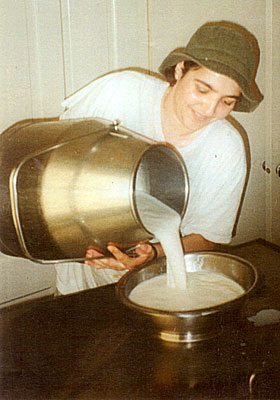 |
| Former intern Nirit Simon shown filtering milk into the bulk tank. Kristan Doolan photo. |
Setting up the paddocks was hard work, because fence lines had to be cut through brush with a chain saw, but the results, after the 2001 grazing season, were encouraging. “There was a really clear increase in production for the goats on browse,” Kristan says.
Although she hasn’t gone over all the data for the 2002 grazing season, Kristan believes that neither parasite numbers nor milk production differed much for that season. So, overall results are somewhat inconclusive.
“One of the problems we’re having is that browse doesn’t come out until June. The grass is much earlier,” Kristan says. “We had all the goats on grass at the end of April until June. Then we were able to put them on browse. The browse doesn’t last as long as the grass either.”
Although the results of the study aren’t crystal clear, Kristan and George say they’ve learned a lot. “We’re going to get some cows,” Kristan says. “After the goats have eaten the grass, then the cows will follow. They don’t share the same internal parasites. The cows will graze it down and then clean up the grass. We don’t know if we’ll raise replacement heifers for cow dairies or some beef cattle.”
Since their goat cheese making enterprise is going well, their overall goal is to figure out how to use the available land best in order to increase their milking goat herd to 30 in 2003 and 40 the following year. To accomplish that they intend to continue to observe their farm and livestock carefully and to experiment.
Kristan and George’s initial experiment as farmers began before they bought their land in Vermont. They were both attending the graduate program in Sustainable Agriculture at the University of Maine at Orono. George had completed an undergraduate degree in agricultural economics and Kristan had a degree in geology when they began their graduate studies. “We went through the Maine program because we wanted to be farmers, not because we wanted to work in other aspects of agriculture,” Kristan says.
They were likely the only yurt dwellers in the graduate program. “One of the best things we did was, when we were in graduate school, we bought a yurt and lived in it. That gave us more flexibility, because we didn’t have to buy a house when we got out. We bought our land and put up the yurt and then slowly put up the barn.” On top of the barn they built an apartment where they live with their two children.
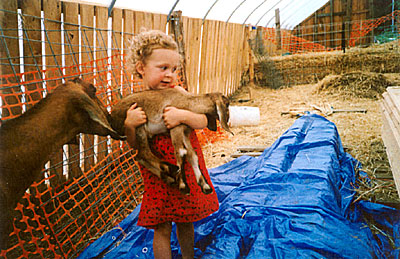 |
| Zoe, Kristan and George’s daughter, holds a baby Nubian goat. Kristan Doolan photo. |
Their experiment with goats began when they bought three does and began trying cheese recipes on their stove at home. Additionally, they pursued every opportunity to learn more about cheese making. “We took several cheese making classes at the University of Vermont,” says Kristan, who is the head cheese maker at Doe’s Leap. “Occasionally cheese makers will travel through the area and give classes. We’ve taken advantage of all of those.”
When they became licensed to sell cheese in 1999, they started selling through the farmer’s market in Burlington. As their herd size grew, they began marketing to area restaurants and through a vegetable CSA farm. Kristan likes the CSA because they don’t have the delivery costs associated with restaurants, and they don’t have to stand for hours at the farmer’s market hoping to sell what they brought.
“It’s worked out well. We package the cheese and drop it off at the vegetable farm once a week,” she says. “We started by sending a flier in the vegetable CSA’s mailer describing our cheeses. Then the customers sent the checks directly to us, and we gave the CSA farm 10 percent of the gross. We have a master list of who bought cheese, and we give that to the farmer with our cheese delivery every week. People usually just want a variety of cheese, so 60 people all get feta one week. That way we don’t have to label things unless somebody has requested something special.”
Selling through as CSA is somewhat like selling wholesale. Doe’s Leap does have a wholesale customer for its organic feta. That customer purchases 50 pounds a week, which is between a third and half of the farm’s current weekly production.
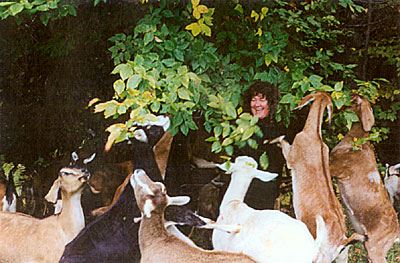 |
| Tracy Walls, yet another University of Maine graduate, feeds a grateful flock of goats some browse. Kristan Doolan photo. |
In addition to feta, Kristan makes what she describes as a typical fresh goat cheese that she calls a fresh chevre. She also makes a raw milk cheese called a tomme, but her farmer’s market customers like her caprella best. Caprella can be found only at Doe’s Leap. “It’s actually modeled after a little Italian cheese called a Toma,” Kristan says. “It’s a soft white cheese in a white moldy rind, sort of like a camembert. Its flavor is mild and slightly tart, and it has a sort of a soft interior. The white mold forms a rind and seals in the moisture. The molds change the composition of the milk, and they get the curd to have that liquidy texture that you see in a brie. It also gives cheeses a little bit of a mushroomy flavor.”
Since the demand is strong for cheeses from Doe’s Leap farm, Kristan and George would like to expand their herd immediately. But goats for certified organic production are in short supply. They’ve got to rely upon their own does to produce kids to expand their herd. Kristan figures it will take about two years to get the herd to the size they want. Meanwhile they will continue to experiment with the best way to raise healthy goats and to produce nutritious organic goat cheeses.
